Effects of Pig Slurry Coupled with Straw Mulching on Soil Nitrogen Dynamics and Maize Growth
Abstract
1. Introduction
2. Materials and Methods
2.1. Study Site and Collection of Samples
2.2. Sample Collection and Measurements
2.3. Method of Calculation
2.4. Data Statistics and Analysis
3. Results
3.1. Soil Available Nitrogen
3.2. Maize Nutrient Absorption
4. Discussion
4.1. Effects of Straw Mulching and Pig Slurry on Migration of Soil Nitrogen Along Soil Profile
4.2. Effects of Straw Mulching and Pig Slurry on Maize Yield, Nitrogen Uptake, and Nitrogen Balance
5. Conclusions
Supplementary Materials
Author Contributions
Funding
Institutional Review Board Statement
Informed Consent Statement
Data Availability Statement
Acknowledgments
Conflicts of Interest
References
- Robertson, G.P.; Vitousek, P.M. Nitrogen in agriculture: Balancing the cost of an essential resource. Annu. Rev. Environ. Resour. 2009, 34, 97–125. [Google Scholar] [CrossRef]
- Guo, C.; Liu, X.; He, X. A global meta-analysis of crop yield and agricultural greenhouse gas emissions under nitrogen fertilizer application. Sci. Total Environ. 2022, 831, 154982. [Google Scholar] [CrossRef]
- Kahrl, F.; Li, Y.; Su, Y.; Tennigkeit, T.; Wilkes, A.; Xu, J. Greenhouse gas emissions from nitrogen fertilizer use in China. Environ. Sci. Policy 2010, 13, 688–694. [Google Scholar] [CrossRef]
- Xu, X.; Liu, X.; He, P.; Johnston, A.M.; Zhao, S.; Qiu, S.; Zhou, W. Yield gap, indigenous nutrient supply and nutrient use efficiency for maize in China. PLoS ONE 2015, 10, e0140767. [Google Scholar] [CrossRef]
- Yang, X.; Fang, S. Practices, perceptions, and implications of fertilizer use in East-Central China. Ambio 2015, 44, 647–652. [Google Scholar] [CrossRef] [PubMed]
- Zhang, M.; Tian, Y.; Zhao, M.; Yin, B.; Zhu, Z. The assessment of nitrate leaching in a rice–wheat rotation system using an improved agronomic practice aimed to increase rice crop yields. Agric. Ecosyst. Environ. 2017, 241, 100–109. [Google Scholar] [CrossRef]
- Wang, X.; Cai, D.; Hoogmoed, W.B.; Oenema, O. Regional distribution of nitrogen fertilizer use and N-saving potential for improvement of food production and nitrogen use efficiency in China. J. Sci. Food Agric. 2011, 91, 2013–2023. [Google Scholar] [CrossRef] [PubMed]
- Zubair, M.; Wang, S.; Zhang, P.; Ye, J.; Liang, J.; Nabi, M.; Zhou, Z.; Tao, X.; Chen, N.; Sun, K. Biological nutrient removal and recovery from solid and liquid livestock manure: Recent advance and perspective. Bioresour. Technol. 2020, 301, 122823. [Google Scholar] [CrossRef]
- Gao, C.; El-Sawah, A.M.; Ali, D.F.I.; Alhaj, H.Y.; Shaghaleh, H.; Sheteiwy, M.S. The integration of bio and organic fertilizers improve plant growth, grain yield, quality and metabolism of hybrid maize (Zea mays L.). Agronomy 2020, 10, 319. [Google Scholar] [CrossRef]
- Wang, J.; Zhang, X.; Yuan, M.; Sun, Y. Effects of partial replacement of nitrogen fertilizer with organic fertilizer on rice growth, nitrogen utilization efficiency and soil properties in the Yangtze River basin. Life 2023, 13, 624. [Google Scholar] [CrossRef]
- Ichihashi, Y.; Date, Y.; Shino, A.; Shimizu, T.; Shibata, A.; Kumaishi, K.; Funahashi, F.; Wakayama, K.; Yamazaki, K.; Umezawa, A. Multi-omics analysis on an agroecosystem reveals the significant role of organic nitrogen to increase agricultural crop yield. Proc. Natl. Acad. Sci. USA 2020, 117, 14552–14560. [Google Scholar] [CrossRef] [PubMed]
- Zhang, M.; Yao, Y.; Tian, Y.; Ceng, K.; Zhao, M.; Zhao, M.; Yin, B. Increasing yield and N use efficiency with organic fertilizer in Chinese intensive rice cropping systems. Field Crops Res. 2018, 227, 102–109. [Google Scholar] [CrossRef]
- Bhogal, A.; Williams, J.; Nicholson, F.; Chadwick, D.; Chambers, K.; Chambers, B. Mineralization of organic nitrogen from farm manure applications. Soil Use Manag. 2016, 32, 32–43. [Google Scholar] [CrossRef]
- Frick, H.; Oberson, A.; Frossard, E.; Bünemann, E.K. Leached nitrate under fertilised loamy soil originates mainly from mineralisation of soil organic N. Agric. Ecosyst. Environ. 2022, 338, 108093. [Google Scholar] [CrossRef]
- Yang, Y.; Lei, T.; Du, W.; Liang, C.; Li, H.; Lv, J. Substituting chemical fertilizer nitrogen with organic manure and comparing their nitrogen use efficiency and winter wheat yield. J. Agric. Sci. 2020, 158, 262–268. [Google Scholar] [CrossRef]
- Blanco-Canqui, H.; Lal, R. Soil structure and organic carbon relationships following 10 years of wheat straw management in no-till. Soil Tillage Res. 2007, 95, 240–254. [Google Scholar] [CrossRef]
- Fan, H.; Jia, S.; Yu, M.; Chen, X.; Shen, A.; Su, Y. Long-term straw return increases biological nitrogen fixation by increasing soil organic carbon and decreasing available nitrogen in rice–rape rotation. Plant Soil 2022, 479, 267–279. [Google Scholar] [CrossRef]
- Zhang, M.; Dang, P.; Haegeman, B.; Han, X.; Wang, X.; Pu, X.; Qin, X.; Siddique, K.M. The effects of straw return on soil bacterial diversity and functional profiles: A meta-analysis. Soil Biol. Biochem. 2024, 195, 109484. [Google Scholar] [CrossRef]
- Yang, H.; Yang, B.; Dai, Y.; Dai, Y.; Xu, M.; Koide, R.T.; Wang, X.; Liu, J.; Bian, X. Soil nitrogen retention is increased by ditch-buried straw return in a rice-wheat rotation system. Eur. J. Agron. 2015, 69, 52–58. [Google Scholar] [CrossRef]
- Dămătîrcă, C.; Moretti, B.; Bertora, C.; Ferrarini, A.; Lerda, C.; Mania, I.; Celi, L.; Gorra, R.; Zavattaro, L. Residue incorporation and organic fertilisation improve carbon and nitrogen turnover and stabilisation in maize monocropping. Agric. Ecosyst. Environ. 2023, 342, 108255. [Google Scholar] [CrossRef]
- Li, Z.; Shen, Y.; Zhang, W.; Zhang, H.; Liu, L.; Wang, Z.; Gu, J.; Yang, J. Effects of long-term straw returning on rice yield and soil properties and bacterial community in a rice-wheat rotation system. Field Crops Res. 2023, 291, 108800. [Google Scholar] [CrossRef]
- Wang, S.; Lu, C.; Huai, S.; Yan, Z.; Wang, J.; Sun, J.; Raza, S. Straw burial depth and manure application affect the straw-C and N sequestration: Evidence from 13C & 15N-tracing. Soil Tillage Res. 2021, 208, 104884. [Google Scholar]
- Luxhøi, J.; Elsgaard, L.; Thomsen, I.K.; Jensen, L. Effects of long-term annual inputs of straw and organic manure on plant N uptake and soil N fluxes. Soil Use Manag. 2007, 23, 368–373. [Google Scholar] [CrossRef]
- Zhang, Y.; Li, C.; Wang, Y.; Hu, Y.; Christie, P.; Zhang, J.; Li, X. Maize yield and soil fertility with combined use of compost and inorganic fertilizers on a calcareous soil on the North China Plain. Soil Tillage Res. 2016, 155, 85–94. [Google Scholar] [CrossRef]
- Šimon, T.; Kunzová, E.; Friedlová, M. The effect of digestate, cattle slurry and mineral fertilization on the winter wheat yield and soil quality parameters. Plant Soil Environ. 2015, 61, 522–527. [Google Scholar] [CrossRef]
- Shi, Y.; Li, T.; Zheng, L.; Jing, X.; Hussain, H.A.; Zhang, Q. Enhancing soil multifunctionality through restoring erosion environment and microbial functions combined with organic manure and straw mulching. Agric. Ecosyst. Environ. 2025, 383, 109515. [Google Scholar] [CrossRef]
- Pfarr, C.J.; Wilson, M.L.; Coulter, J.A.; Fernández, F.G. Liquid swine manure as a sidedressed nitrogen source for corn. Agron. J. 2020, 112, 5206–5221. [Google Scholar] [CrossRef]
- Shi, Z.; Li, D.; Jing, Q.; Caii, J.; Jiang, D.; Cao, W.; Dai, T. Effects of nitrogen applications on soil nitrogen balance and nitrogen utilization of winter wheat in a rice–wheat rotation. Field Crops Res. 2012, 127, 241–247. [Google Scholar] [CrossRef]
- Wang, L.; Zhou, H.; Fei, C. Substituting partial chemical nitrogen fertilizers with organic fertilizers maintains grain yield and increases nitrogen use efficiency in maize. Front. Plant Sci. 2024, 15, 1442123. [Google Scholar] [CrossRef]
- Balík, J.; Cerny, J.; Tlustos, P.; Zitková, M. Nitrogen balance and mineral nitrogen content in the soil in a long experiment with maize under different systems of N fertilization. Plant Soil Environ. 2003, 49, 554–559. [Google Scholar] [CrossRef]
- Moklyachuk, L.; Furdychko, O.; Pinchuk, V.; Mokliachuk, O.; Draga, M. Nitrogen balance of crop production in Ukraine. J. Environ. Manag. 2019, 246, 860–867. [Google Scholar] [CrossRef]
- Liu, L.; Wen, Z.; Liu, S.; Zhang, X.; Liu, X. Decline in atmospheric nitrogen deposition in China between 2010 and 2020. Nat. Geosci. 2024, 17, 733–736. [Google Scholar] [CrossRef]
- Liu, C.; Watanabe, M.; Wang, Q. Changes in nitrogen budgets and nitrogen use efficiency in the agroecosystems of the Changjiang River basin between 1980 and 2000. Nutr. Cycl. Agroecosyst. 2008, 80, 19–37. [Google Scholar] [CrossRef]
- Gong, W.; Yan, X.; Wang, J.; Hu, T.; Gong, Y. Long-term applications of chemical and organic fertilizers on plant-available nitrogen pools and nitrogen management index. Biol. Fertil. Soils 2011, 47, 767–775. [Google Scholar] [CrossRef]
- Yang, Q.; Liu, P.; Dong, S.; Zhang, J.; Zhao, B. Combined application of organic and inorganic fertilizers mitigates ammonia and nitrous oxide emissions in a maize field. Nutr. Cycl. Agroecosyst. 2020, 117, 13–27. [Google Scholar] [CrossRef]
- Du, H.Y.; Gao, W.X.; Li, J.J.; Shen, S.Z.; Wang, F.; Fu, L.; Zhang, K.Q. Effects of digested biogas slurry application mixed with irrigation water on nitrate leaching during wheat-maize rotation in the North China Plain. Agric. Water Manag. 2019, 213, 882–893. [Google Scholar] [CrossRef]
- Zinn, Y.L.; Marrenjo, G.J.; Silva, C.A. Soil C:N ratios are unresponsive to land use change in Brazil: A comparative analysis. Agric. Ecosyst. Environ. 2018, 255, 62–72. [Google Scholar] [CrossRef]
- Zhao, Z.C.; Fu, L.Y.; Yao, L.; Wang, Y.Q.; Li, Y. Replacing chemical fertilizer with separated biogas slurry to reduce soil nitrogen loss and increase crop yield—A two-year field study. Agronomy 2024, 14, 1173. [Google Scholar] [CrossRef]
- Maris, S.C.; Abalos, D.; Capra, F.; Moscatelli, G.; Scaglia, F.; Reyes, G.E.C.; Ardenti, F.; Boselli, R.; Ferrarini, A.; Mantovi, P.; et al. Strong potential of slurry application timing and method to reduce N losses in a permanent grassland. Agric. Ecosyst. Environ. 2021, 311, 107329. [Google Scholar] [CrossRef]
- Martínez-García, L.B.; Korthals, G.W.; Brussaard, L.; Mainardi, G.; De Deyn, G.B. Litter quality drives nitrogen release, and agricultural management (organic vs. conventional) drives carbon loss during litter decomposition in agro-ecosystems. Soil Biol. Biochem. 2021, 153, 108115. [Google Scholar] [CrossRef]
- Asibi, A.E.; Chai, Q.; Coulter, J.A. Mechanisms of nitrogen use in maize. Agronomy 2019, 9, 775. [Google Scholar] [CrossRef]
- Aita, C.; Recous, S.; Cargnin, R.H.O.; da Luz, L.P.; Giacomini, S.J. Impact on C and N dynamics of simultaneous application of pig slurry and wheat straw, as affected by their initial locations in soil. Biol. Fertil. Soils. 2012, 48, 633–642. [Google Scholar] [CrossRef]
- Barłóg, P.; Hlisnikovský, L.; Kunzová, E. Effect of digestate on soil organic carbon and plant-available nutrient content compared to cattle slurry and mineral fertilization. Agronomy 2020, 10, 379. [Google Scholar] [CrossRef]
- Stotter, M.; Wichern, F.; Pude, R.; Hamer, M. Utilisation of miscanthus x giganteus L. Based C-rich fertilisers for N immobilisation and microbial biomass build-up in a crop rotation. Agronomy 2021, 11, 2390. [Google Scholar]
- Haruna, S.I.; Nkongolo, N.V. Cover crop management effects on soil physical and biological properties. Procedia. Environ. Sci. 2015, 29, 13–14. [Google Scholar] [CrossRef]
- Pathan, S.I.; Ceccherini, M.T.; Pietramellara, G.; Puschenreiter, M.; Giagnoni, L.; Arenella, M.; Varanini, Z.; Nannpieri, P.; Renella, G. Enzyme activity and microbial community structure in the rhizosphere of two maize lines differing in N use efficiency. Plant Soil 2015, 387, 413–424. [Google Scholar] [CrossRef]
- Lv, P.; Sun, S.S.; Zhao, X.Y.; Li, Y.Q.; Zhao, S.L.; Zhang, J.; Hu, Y.; Guo, A.X.; Yue, P.; Zuo, X.A. Effects of altered precipitation patterns on soil nitrogen transformation in different landscape types during the growing season in Northern China. Catena 2023, 222, 106813. [Google Scholar] [CrossRef]
- Xie, M.Z.; Zhao, L.; Wu, X.D.; Tian, L.M.; Yue, G.Y.; Zhou, H.Y.; Wu, Z.M. Seasonal variations of nitrogen in permafrost-affected soil of the Qinghai-Tibetan Plateau. Catena 2020, 195, 104793. [Google Scholar] [CrossRef]
- Zhang, L.; Tang, C.; Yang, J.S.; Yao, R.J.; Wang, X.P.; Xie, W.P.; Ge, A.H. Salinity-dependent potential soil fungal decomposers under straw amendment. Sci. Total Environ. 2023, 891, 164569. [Google Scholar] [CrossRef]
- Hua, W.; Luo, P.; An, N.; Cai, J.; Zhang, S.; Chen, K.; Yang, J.; Han, X. Manure application increased crop yields by promoting nitrogen use efficiency in the soils of 40-year soybean-maize rotation. Sci. Rep. 2020, 10, 14882. [Google Scholar] [CrossRef]
- Duan, Y.; Xu, M.; Wang, B.; Yang, X.; Huang, S.; Gao, S. Long-term evaluation of manure application on maize yield and nitrogen use efficiency in China. Soil Sci. Soc. Am. J. 2011, 75, 1562–1573. [Google Scholar] [CrossRef]
- Geng, Y.; Cao, G.; Wang, L.; Wang, S. Effects of equal chemical fertilizer substitutions with organic manure on yield, dry matter, and nitrogen uptake of spring maize and soil nitrogen distribution. PLoS ONE 2019, 14, e0219512. [Google Scholar] [CrossRef]
- Xia, L.; Lam, S.K.; Yan, X.; Chen, D. How does recycling of livestock manure in agroecosystems affect crop productivity, reactive nitrogen losses, and soil carbon balance? Environ. Sci. Technol. 2017, 51, 7450–7457. [Google Scholar] [CrossRef]
- Zhai, L.; Wang, Z.; Zhai, Y.; Zhang, L.; Zheng, M.; Yao, H.; Lv, L.; Shen, H.; Zhang, J.; Yao, Y. Partial substitution of chemical fertilizer by organic fertilizer benefits grain yield, water use efficiency, and economic return of summer maize. Soil Tillage Res. 2022, 217, 105287. [Google Scholar] [CrossRef]
- Zhao, K.; Huang, M.; Li, Y.; Wu, J.; Tian, W.; Li, J.; Hou, Y.; Wu, S.; Zhang, J.; Zhang, Z. Combined organic fertilizer and straw return enhanced summer maize productivity and optimized soil nitrate–N distribution in rainfed summer maize–winter wheat rotation on the Southeast Loess Plateau. J. Soil Sci. Plant Nutr. 2023, 23, 938–952. [Google Scholar] [CrossRef]
- Demelash, N.; Bayu, W.; Tesfaye, S.; Ziadat, F.; Sommer, R. Current and residual effects of compost and inorganic fertilizer on wheat and soil chemical properties. Nutr. Cycl. Agroecosyst. 2014, 100, 357–367. [Google Scholar] [CrossRef]
- Cheng, Y.; Wang, J.; Wang, J.; Chang, S.X.; Wang, S. The quality and quantity of exogenous organic carbon input control microbial NO3− immobilization: A meta-analysis. Soil Biol. Biochem. 2017, 115, 357–363. [Google Scholar] [CrossRef]
- Azam, F.; Malik, K.; Sajjad, M. Transformations in soil and availability to plants of 15 N applied as inorganic fertilizer and legume residues. Plant soil 1985, 86, 3–13. [Google Scholar] [CrossRef]
- Huygens, D.; Díaz, S.; Urcelay, C.; Boeckx, P. Microbial recycling of dissolved organic matter confines plant nitrogen uptake to inorganic forms in a semi—Arid ecosystem. Soil Biol. Biochem. 2016, 101, 142–151. [Google Scholar] [CrossRef]
- Zhang, H.; Ma, Y.; Shao, J.Z.; Di, R.; Zhu, F.; Yang, Z.C.; Sun, J.S.; Zhang, X.Y.; Zheng, C.Y. Changes in soil bacterial community and functions by substituting chemical fertilizer with biogas slurry in an apple orchard. Front. Plant Sci. 2022, 13, 1013184. [Google Scholar] [CrossRef]
- Huang, S.Y.; Gao, X.; Zeng, L.; Zhang, M.L.; Zhang, L.Y.; Wang, S.Y.; Zhao, Y.Z.; Zhou, W.; Ai, C. Microbial role in enhancing transfer of straw-derived nitrogen to wheat under nitrogen fertilization. Soil Tillage Res. 2024, 239, 106037. [Google Scholar] [CrossRef]
- Li, J.; Zhong, F. Nitrogen release and re-adsorption dynamics on crop straw residue during straw decomposition in an Alfisol. J. Integr. Agric. 2021, 20, 248–259. [Google Scholar] [CrossRef]
- Christensen, B.T.; Olesen, J.E. Nitrogen mineralization potential of organomineral size separates from soils with annual straw incorporation. Eur. J. Soil Sci. 1998, 49, 25–36. [Google Scholar] [CrossRef]
- Guan, X.; Wei, L.; Turner, N.C.; Ma, S.; Yang, M.; Wang, T. Improved straw management practices promote in situ straw decomposition and nutrient release, and increase crop production. J. Clean. Prod. 2020, 250, 119514. [Google Scholar] [CrossRef]
- Liu, J.; Jiang, B.; Shen, J.; Zhu, X.; Yi, W.; Li, Y.; Wu, J. Contrasting effects of straw and straw-derived biochar applications on soil carbon accumulation and nitrogen use efficiency in double-rice cropping systems. Agric. Ecosyst. Environ. 2021, 311, 107286. [Google Scholar] [CrossRef]
- Wang, X.; Wang, X.; Geng, P.; Yang, Q.; Chen, K.; Liu, N.; Fang, Y.; Zhan, X.; Han, X. Effects of different returning method combined with decomposer on decomposition of organic components of straw and soil fertility. Sci. Rep. 2021, 11, 15495. [Google Scholar] [CrossRef]
- Wang, M.; Wang, L.; Cui, Z.; Chen, X.; Xie, J.; Hou, Y. Closing the yield gap and achieving high N use efficiency and low apparent N losses. Field Crops Res. 2017, 209, 39–46. [Google Scholar] [CrossRef]
- Ciampitti, I.A.; Vyn, T.J. A comprehensive study of plant density consequences on nitrogen uptake dynamics of maize plants from vegetative to reproductive stages. Field Crops Res. 2011, 121, 2–18. [Google Scholar] [CrossRef]
- Agegnehu, G.; Nelson, P.N.; Bird, M.I. The effects of biochar, compost and their mixture and nitrogen fertilizer on yield and nitrogen use efficiency of barley grown on a Nitisol in the highlands of Ethiopia. Sci. Total Environ. 2016, 569, 869–879. [Google Scholar] [CrossRef]
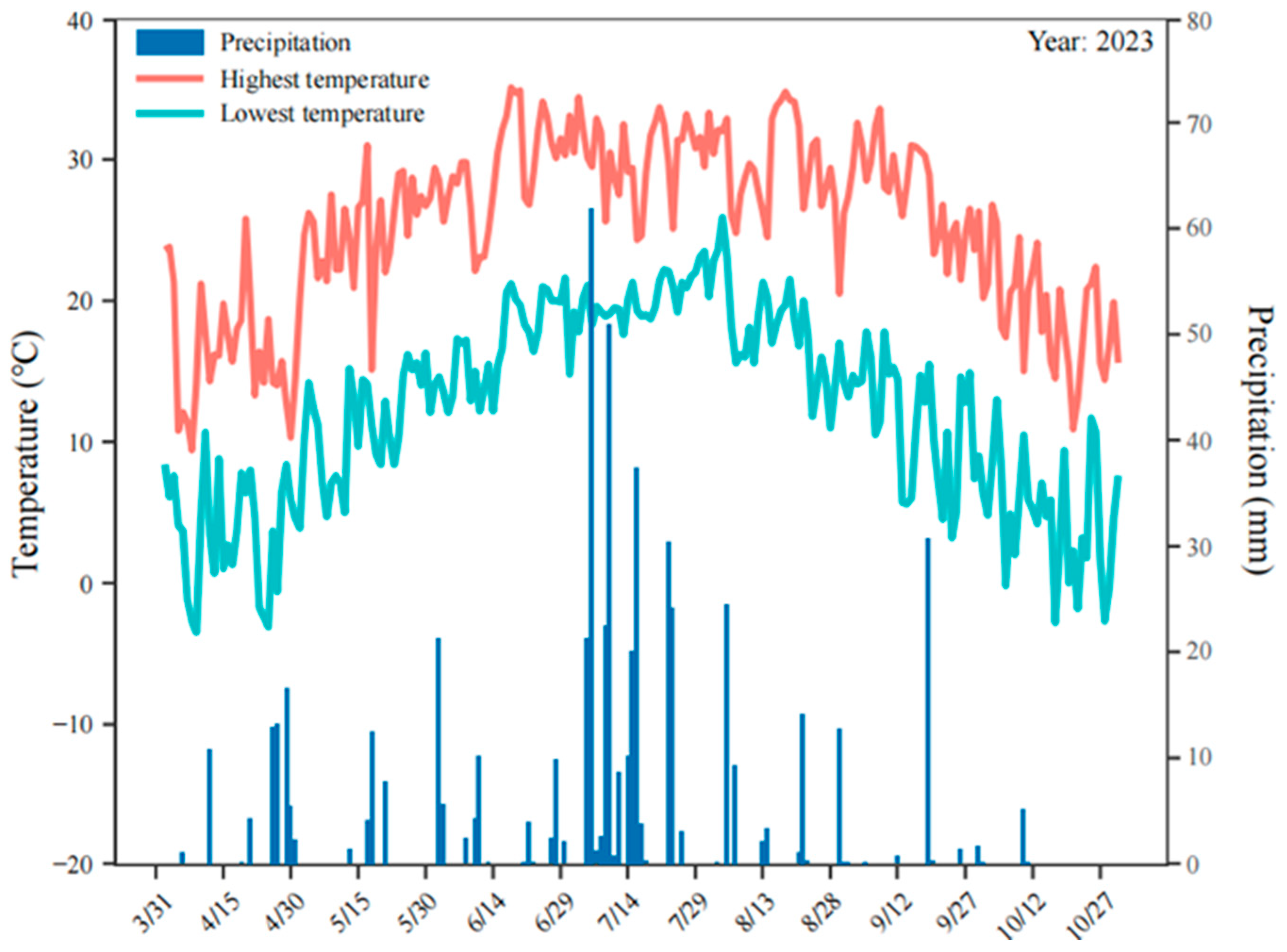
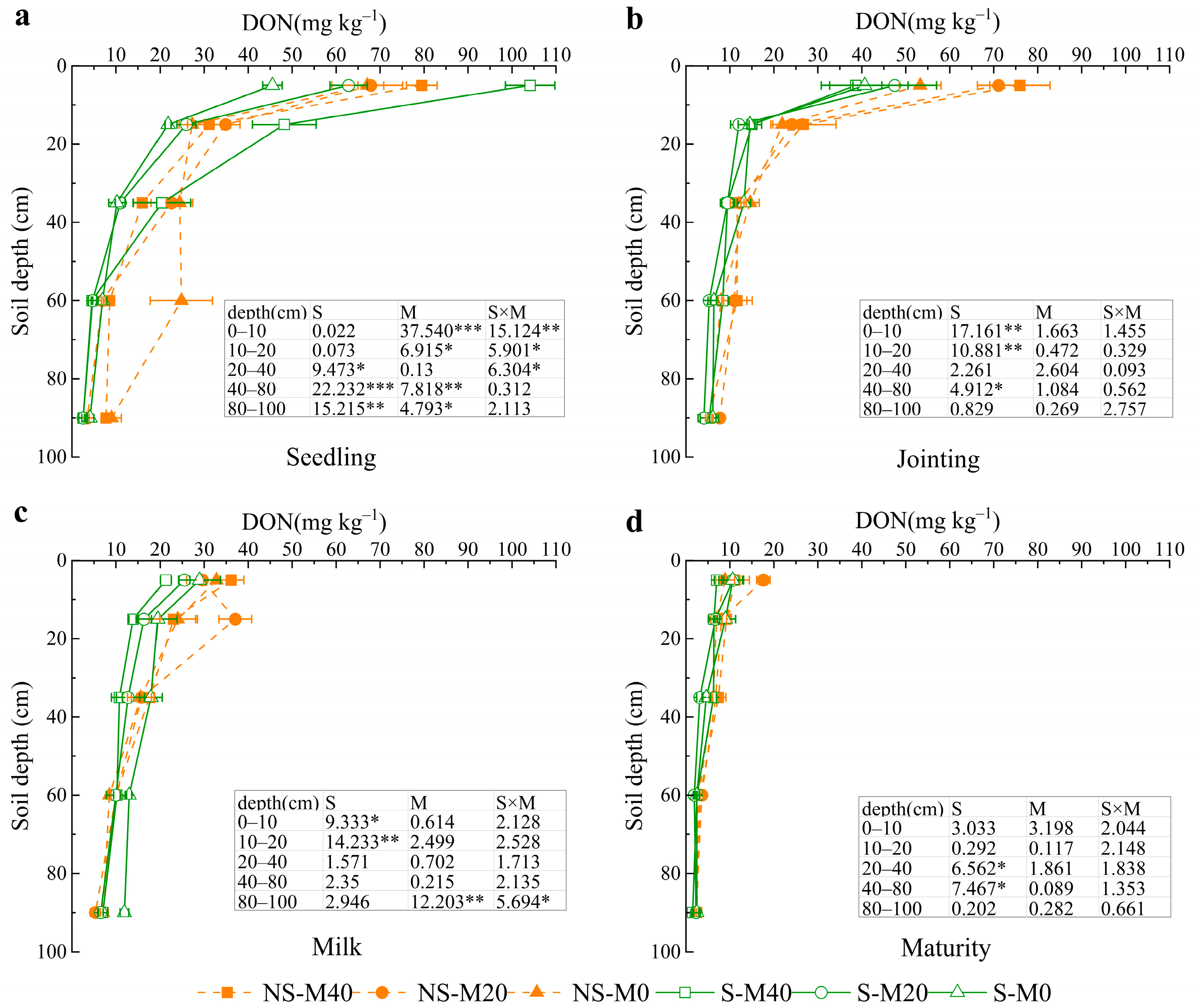
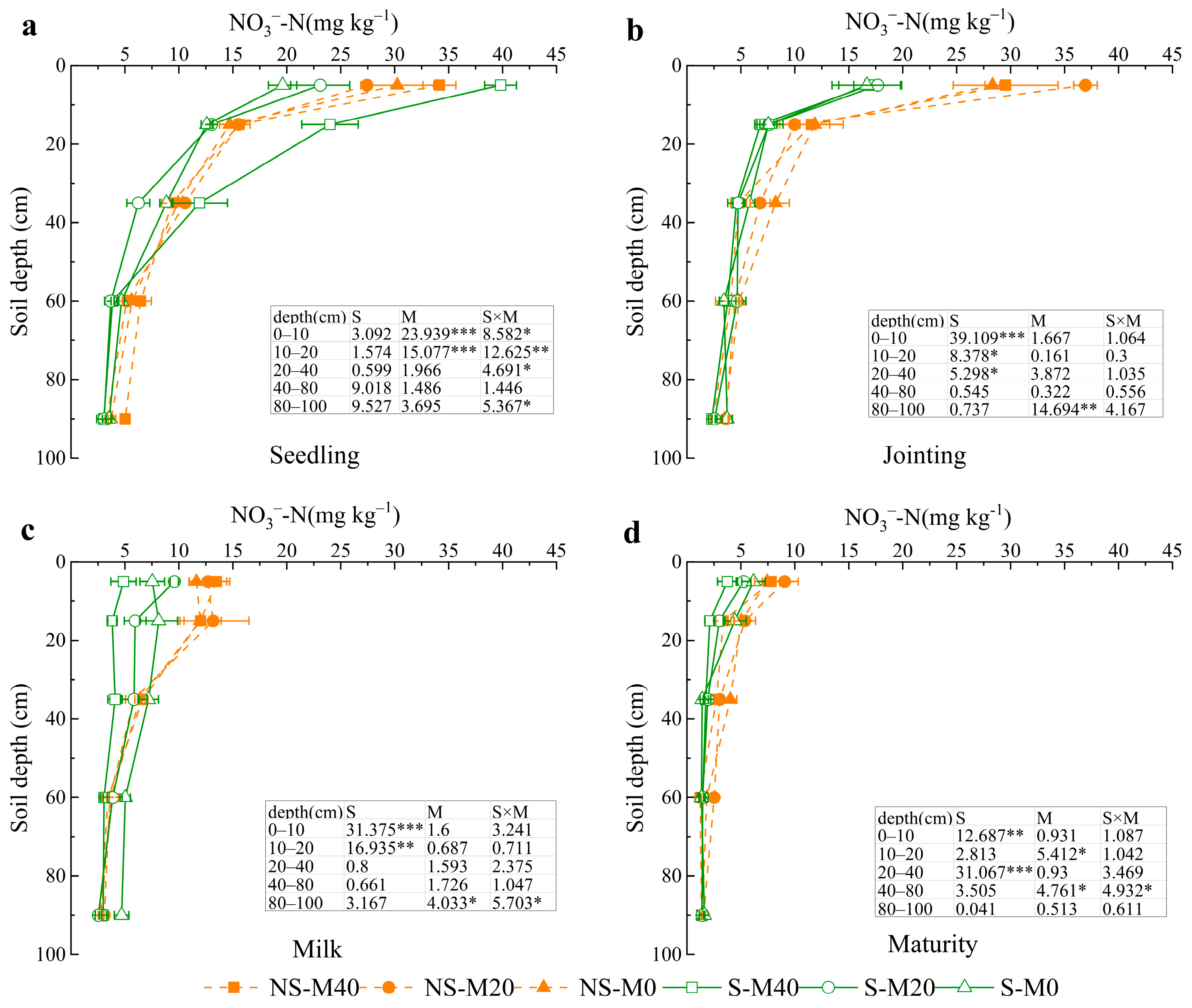

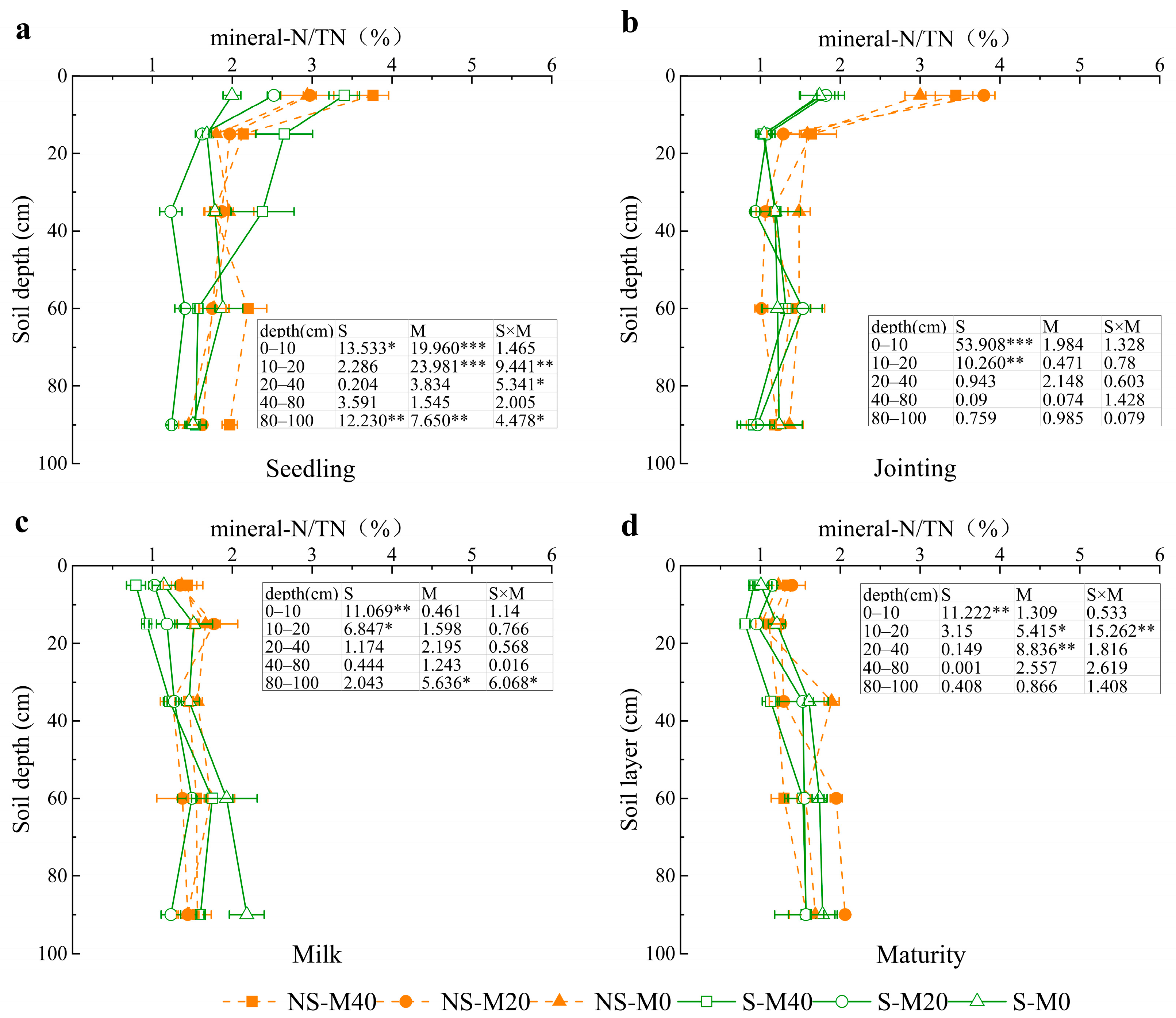
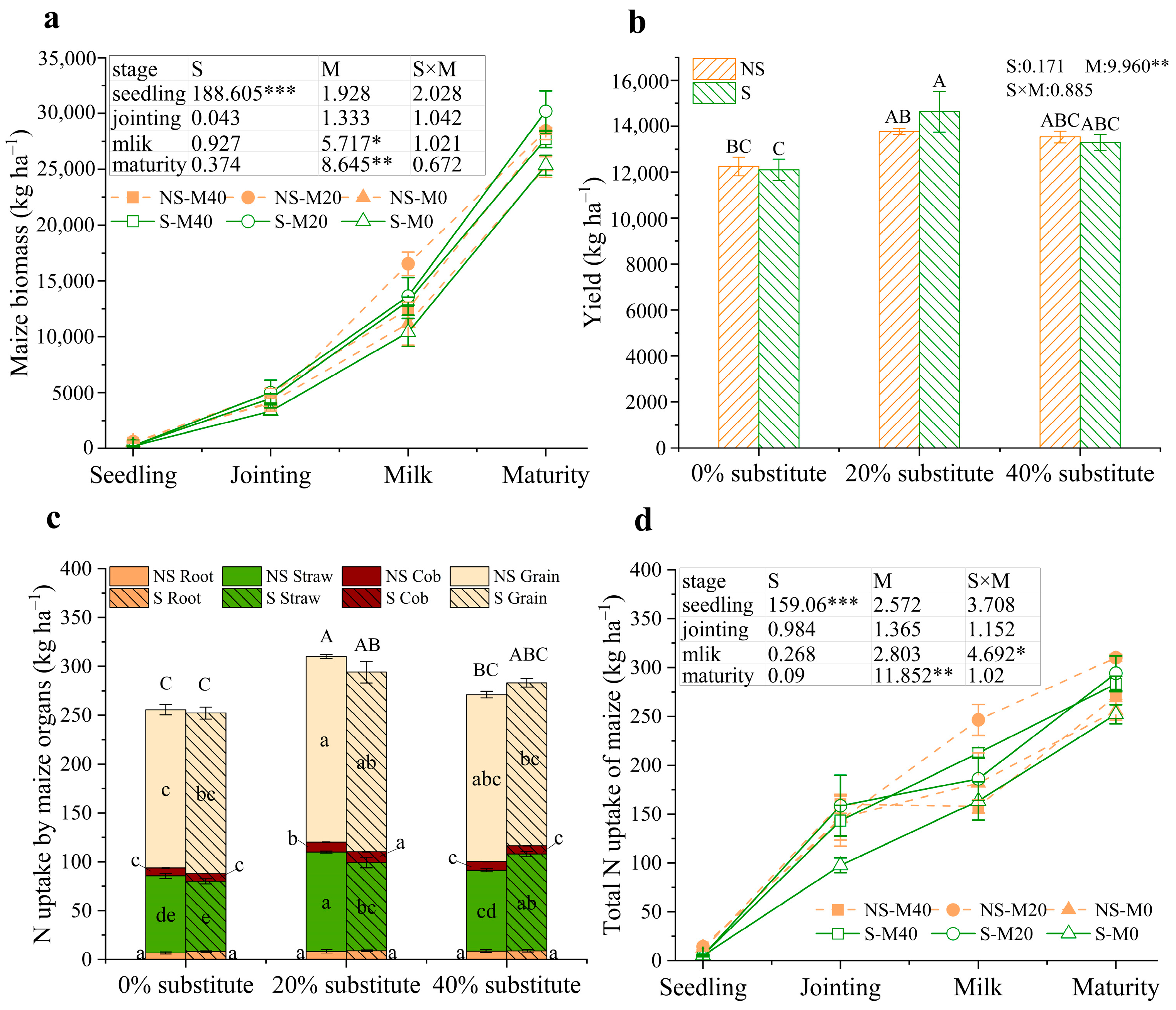
| Treatment | Input of Chemical Fertilizer (kg ha−1) | Input of Pig Slurry (kg ha−1) | ||||
|---|---|---|---|---|---|---|
| N | P2O5 | K2O | N | P2O5 | K2O | |
| NS-M0 | 220 | 76 | 110 | 0 | 0 | 0 |
| NS-M20 | 176 | 60.8 | 88 | 44 | 15.2 | 22 |
| NS-M40 | 132 | 45.6 | 66 | 88 | 30.4 | 44 |
| S-M0 | 220 | 76 | 110 | 0 | 0 | 0 |
| S-M20 | 176 | 60.8 | 88 | 44 | 15.2 | 22 |
| S-M40 | 132 | 45.6 | 66 | 88 | 30.4 | 44 |
| Treatment | N Inputs | N Outputs | Difference (Inputs−Outputs) | ||||
|---|---|---|---|---|---|---|---|
| Nfertilizer | Npig slurry | Nstraw | Ndeposition | Nbio fixation | Nmaize uptake | ||
| (kg ha−1) | (kg ha−1) | (kg ha−1) | (kg ha−1) | (kg ha−1) | (kg ha−1) | ||
| NS-M0 | 220 | 0 | 0 | 16 | 15 | 249.07 | 1.93 |
| NS-M20 | 176 | 44 | 0 | 16 | 15 | 301.81 | −50.81 |
| NS-M40 | 132 | 88 | 0 | 16 | 15 | 262.24 | −11.24 |
| S-M0 | 220 | 0 | 67.5 | 16 | 15 | 243.85 | 74.65 |
| S-M20 | 176 | 44 | 67.5 | 16 | 15 | 285.15 | 33.35 |
| S-M40 | 132 | 88 | 67.5 | 16 | 15 | 274.22 | 44.28 |
Disclaimer/Publisher’s Note: The statements, opinions and data contained in all publications are solely those of the individual author(s) and contributor(s) and not of MDPI and/or the editor(s). MDPI and/or the editor(s) disclaim responsibility for any injury to people or property resulting from any ideas, methods, instructions or products referred to in the content. |
© 2025 by the authors. Licensee MDPI, Basel, Switzerland. This article is an open access article distributed under the terms and conditions of the Creative Commons Attribution (CC BY) license (https://creativecommons.org/licenses/by/4.0/).
Share and Cite
Yang, Y.; Lei, D.; Zhang, Y.; Zhao, Z.; Xie, H.; Deng, F.; Bao, X.; Zhang, X.; He, H. Effects of Pig Slurry Coupled with Straw Mulching on Soil Nitrogen Dynamics and Maize Growth. Agronomy 2025, 15, 1062. https://doi.org/10.3390/agronomy15051062
Yang Y, Lei D, Zhang Y, Zhao Z, Xie H, Deng F, Bao X, Zhang X, He H. Effects of Pig Slurry Coupled with Straw Mulching on Soil Nitrogen Dynamics and Maize Growth. Agronomy. 2025; 15(5):1062. https://doi.org/10.3390/agronomy15051062
Chicago/Turabian StyleYang, Yali, Dengchao Lei, Yulan Zhang, Zhe Zhao, Hongtu Xie, Fangbo Deng, Xuelian Bao, Xudong Zhang, and Hongbo He. 2025. "Effects of Pig Slurry Coupled with Straw Mulching on Soil Nitrogen Dynamics and Maize Growth" Agronomy 15, no. 5: 1062. https://doi.org/10.3390/agronomy15051062
APA StyleYang, Y., Lei, D., Zhang, Y., Zhao, Z., Xie, H., Deng, F., Bao, X., Zhang, X., & He, H. (2025). Effects of Pig Slurry Coupled with Straw Mulching on Soil Nitrogen Dynamics and Maize Growth. Agronomy, 15(5), 1062. https://doi.org/10.3390/agronomy15051062






